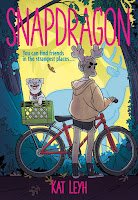Want some silly, unimportant life advice? Enter contests and sweepstakes! If you do, once in a long while you’ll win something cool. At least that’s been the case for me! At the start of the summer I won a box of Pride books from Fierce Reads (Macmillan’s YA publishing arm). It was a lovely surprise, and I immediately was interested in one of the books in particular: Anna-Marie McLemore’s Lakelore, because A) I’ve read their work before, B) the cover was *fire emoji*, and C) the title was just too perfect – I’m spending this summer on a lake.
Everyone who lives near the lake knows the stories about the world underneath it, an ethereal landscape rumored to be half-air, half-water. But Bastián Silvano and Lore Garcia are the only ones who’ve been there. Bastián grew up both above the lake and in the otherworldly space beneath it. Lore’s only seen the world under the lake once, but that one encounter changed their life and their fate.
Then the lines between air and water begin to blur. The world under the lake drifts above the surface. If Bastián and Lore don’t want it bringing their secrets to the surface with it, they have to stop it, and to do that, they have to work together. There’s just one problem: Bastián and Lore haven’t spoken in seven years, and working together means trusting each other with the very things they’re trying to hide.
In short chapters, and using dual perspectives, McLemore spins up a world where two trans/nonbinary teens visit a weird and mystical alternate universe that has something to do with the local lake and its folklore… and maybe their relationship? Lore and Bastián met once as children, and now through circumstance these two queer Mexican American teens are thrown together again, in a vibrant narrative with little sense of the passage of time and/or place (it’s America, and probably California, but it’s not clear where). The work of the book is quiet: unraveling identity, trauma, how the world responds to neurodivergence, how to let others see who you truly are, and more – in a sometimes-dreamlike contemporary fantasy setting.
McLemore’s extensive use of metaphor and personification infuse the text with emotion, and lead to ever-rising stakes until there’s a crescendo – an unraveling and unknotting of stories, hurts, feelings. Both narrators have a lot in common: the way their brains work require adaptation, the trans or nonbinary experience, supportive parents and families, and Mexican American identity. However, they are working with a different set of formative experiences. Lore has recent trauma that is school bullying-related, and Bastián is coping with feelings around starting testosterone (T) and brotherhood.
Things about this book that are absolutely lovely: the way that Bastián describes their mental health as weather, the way Lore expresses their reading process, how old and new trauma are tied up for them with learning, reading aloud (as an educator, this breaks my heart – knowing that even though Lore is fictional, there are children who have been failed just like Lore), the way both characters think and speak about color and art. The way that difficult words and memories can haunt, especially when we are young – but also how acceptance and new experiences can alter our perception, blunt the sting of hurts, or simply bring them into a kinder focus.
So that’s what the book is about, approximately. Let’s get down to business: this book *wrecked* me. Over the final 45 pages, I was crying too hard to read at points, but also simultaneously smiling – feeling heart-full and heartsick, hopeful and tasting that bittersweetness of life that is good and hard at the same time. I cannot believe that McLemore’s writing keeps getting better and better. I felt so deeply during the reading, and I also couldn’t stop thinking that this book would be incredibly important for young queer folks, and also for anyone trying to relate to young LGBTQ+ and neurodivergent kids (especially those dealing with dyslexia and ADHD). It was lovely, literary, and necessary, all in one. And the prose flowed! I’m almost mad at how much I loved this book.
In all, Lakelore is a queer group hug in book form, featuring an in-depth look at the neurodivergent experience, magical realism, and lyrical prose.
Recommended for: fans of A.S. King, soft, mystical fantasy, and LGBTQ+ books, anyone who loves character-driven stories, magical realism, and literary young adult fiction, and teens who really need to see themselves in books, even though they may not know it yet.
Fine print: I received a finished copy of this book in a publisher-sponsored giveaway. I did not receive any compensation for this post.















